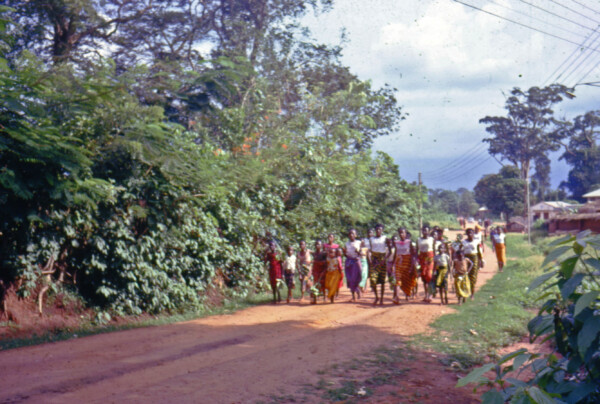This funeral was unusual in that it involved the death of an, unmarried woman (agbogho) closely related to Obiekwe Aniweta’s portion (Umu-Aguzani) of the Umu-Aroli sub-village of Umu-Anyo. The deceased was about 25 years old and her serious mental deficiencies were known to all. The daughter ofr Mr. Ogazi of this sub-village,, she had remained unmarried, living not in the same house as her father but close by. She did not stray far from her village during her brief lifetime.
we arrived at Umu-Aguzani, Umu-Anyo in mid-afternoon, with the rituals well under way.
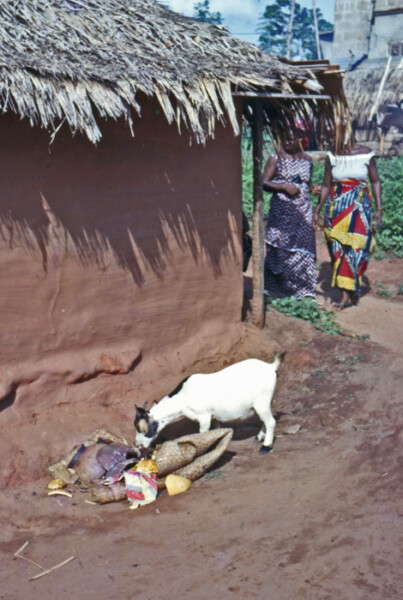
Her death was discovered early this morning, and the elders close by quickly organzied “Notifying the Descent group” (Nkatta Umunna). that their Daughter was ill, doing rituals to protect here, then reasembling everyone as they prepared to leave, telling them she had died. This was followed by “breaking the pot”, a ritual which we failled to see but the image at left shows the results: a local goat eating the remains of a foo-foo stew that had been made for the deceased, together with a piece of her clothing, a calabash with water, the broken pot, the mat on which she had been ill, .
This was left over from the morning. It would be buried with the symbolic coffin (igbudu) near her fathere’s house.
We were somewhat surprised, shortly after our arrival there, to see the large group of unmarried women (Umu-Agbogho) approaching in the image above, who had just visited the Aze shrine devoted to a woman of Umu-Aroli who had attained fame and now had a substantial forest grove named after her. a regular object of ritual attentions among Umu-Aroli. Below you see a closeup of the group, with the older unmarried women in front and younger ones behind, all these having marched through the village in salute of their departed comrade, in the dance, Igbe-ilo, where they sang songs urging nobody to seek another persor’s death.

Below, they continued to run through Umu-Anyo village, past Helen and local villagers.

And here below they depart, out of sight. Meanwhile other villagers were busy at work.
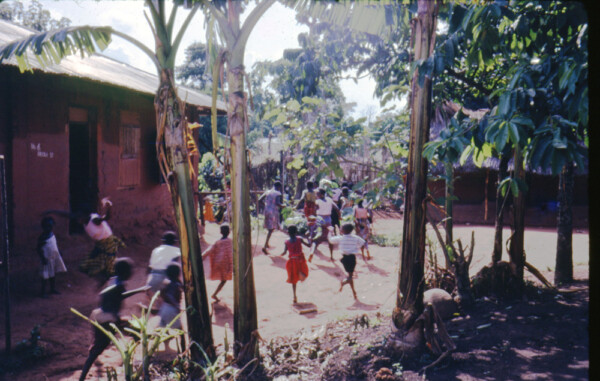
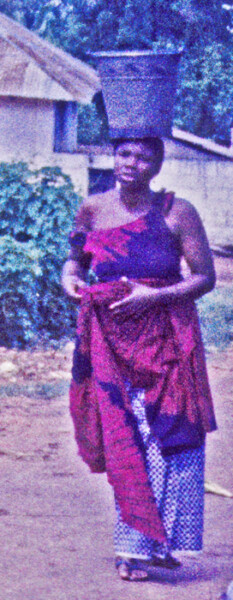
At left, here, I remind viewers that the women of Umu-Anyo are definitely Masters of Poise (I encountered this one, bearing a large, full pail of water near Afia Waya, “The Wire Market”) on another occasion).
.For a young, unmarried person who has died prematurely, Onitsha funerary rituals become highly condensed. While the funeral for a titled man, for example, may be extended over time for several years — the two portions, Burial and Lamentation, involve so much organization, effort, and expense that a long delay may be necessary to mobilize necessary resources — for a young person of the kind we’re discussing here,the burial and the lamentation will likely occur in the same day. This is what had happened at this funeral; the Burial was completed by the time we arrived; the Lamentation was now under way.
But Ndi-Onicha insist on recognizing the dignity of their people, and even a person of small importance who has lived her life as best she could is given respectful dues.
In various parts of t Umu-Anyo, numerous groups of women were engaged in various kinds of preparation.

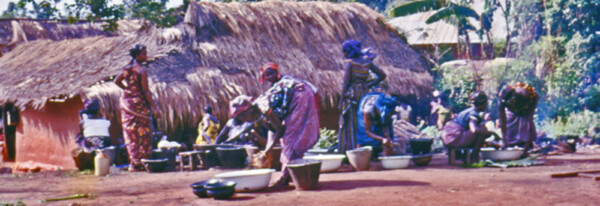
Below, a group of younger women (at right) are involved in their own ritual tasks.


Below, , the village orchestra enters the scene. I believe the large gong is one particularly used during funerals.
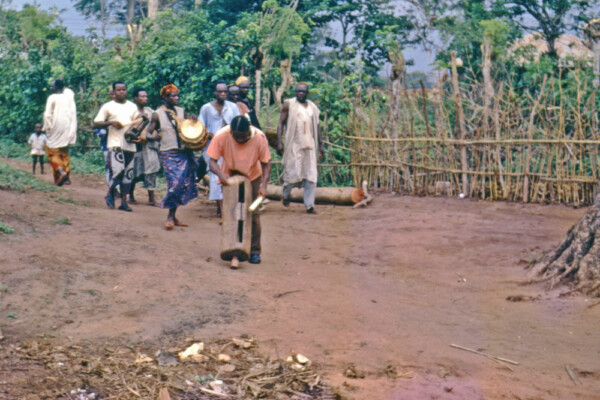
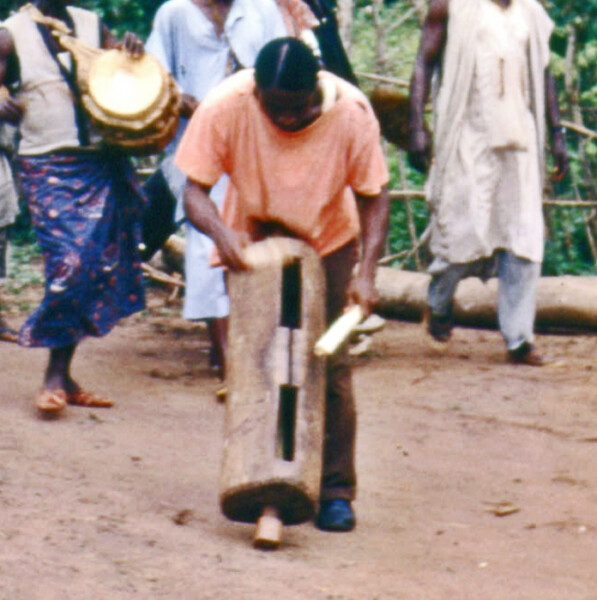
Below, two persons actively supporting the ritual receive drinks from the senior priest.


Below,, senior Daughters (Umu-Ada) of the village await developments.
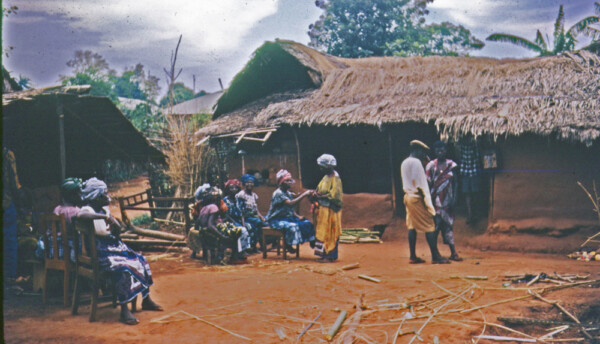
Meanwhile they are being served.
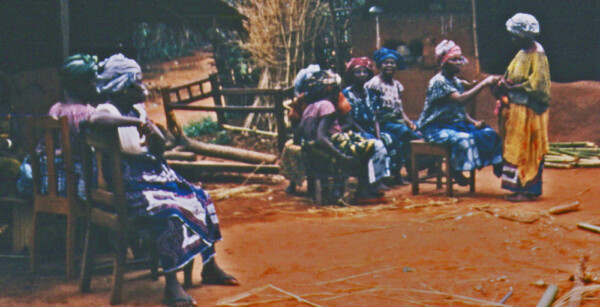
Below, one of the Daughters wears her Odu (ivory ankletes).
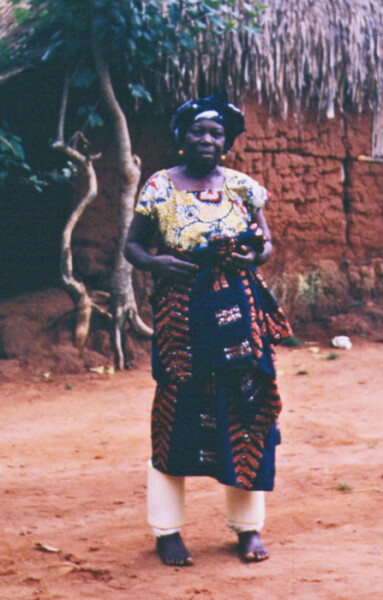
Below, the elders begin the process of building the Igbudu, using the open-work building thaat also harbored a barber shop and also proclaimed itself as an “Institute of Stenography.”
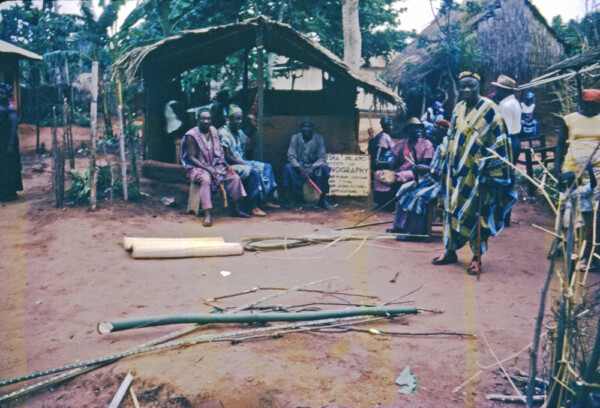
Here they consult on the matter. Nearby the women are also busy. (Note the Umu-Anyo Ezumezu (birth shrine) — the red-painted building in the background.

Below, a village barber shop,
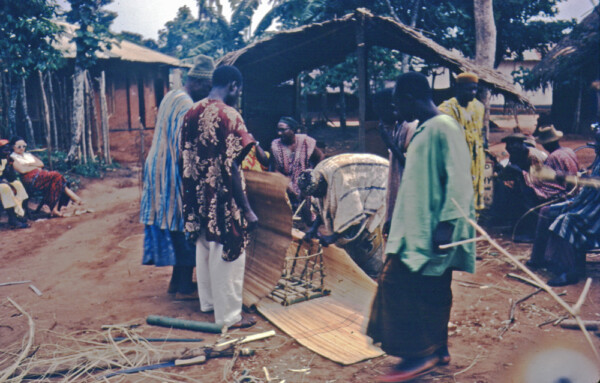
The elders help the Umu-ilo (Youtahs of the village square) Carying the Igbudu to its ritual destination, a nearby house where it is taken inside an further rituals are performed. .

We did not witness this final moment. The Umuada went inside the house, where further rituals were performed Then the Igbudu wass taken back outside, where a female coat was htthered. The umu-ilo brought with them a small dish holding 4 or 5 nkpulu-chi (“pieces of chi”), sticks representing the deceased’s personal god, with kola nuts placed beside them. ( During one’s lifetime, the representations of one’s Chi (personal Deity) cannot receive blood in this manner, but they may at life’s end. Te village youths held up the goat, slit its threat with a knife, and let the blood flow over both Igbudu and Chi sticks.
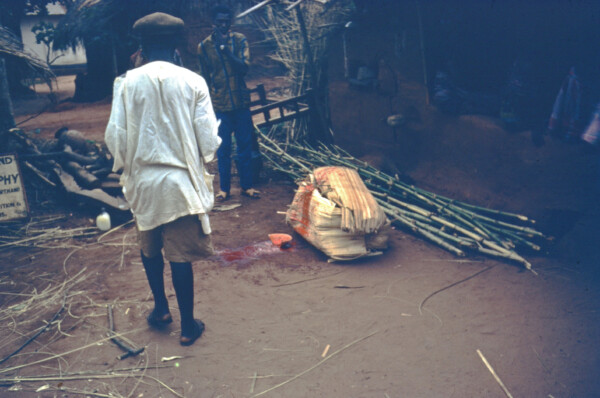


I would like to think that, soon thereafter, with an embracive crowd surrounding her, a resplendent “young woman ghost” (agbogho-mmuo) appears, and, with respectful urging by the elders, proceeds to dance in all her glory, delighting everyone, as we see here at left.
However, I don’t think this happened at this funeral. I think that the “slide” of this image (above) became accidentally misplaced into this folder duuring the times when I presented slide shows to my classes when teaching at the University of Arizona many years ago. I know where this slide should go. Unfortunately, I don’t think the designers of this funeral felt that the life of the woman in question warranted this kind of reincarnative celebration. They deserv every good credit for the degrees of respect they showed for her in her passing.
